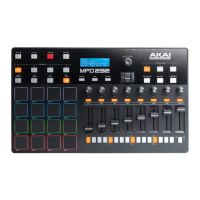6
17. Pads: Use these pads to trigger drum hits or other samples in your software or external
MIDI sound module. The pads are pressure- and velocity-sensitive, which makes them
very responsive and intuitive to play.
18. Pad Bank: Use this button to select one of four independent banks of pads. This lets you
access up to 64 different pads (16 pads across 4 pad banks).
19. Full Level: Press this button to activate Full Level Mode in which the pads always play at
a maximum velocity (127), no matter how hard or soft you hit them.
20. 16 Level: Press this button to activate/deactivate 16 Level. When activated, the last pad
that was hit will be temporarily copied to all 16 pads. The pads will now output the same
note number as the initial pad but at fixed velocity values that increase as the pad
numbers increase (e.g., Pad 1 is the minimum, Pad 16 is the maximum), regardless of
how hard you hit them.
21. Note Repeat: Press and hold this button while striking a pad to cause the pad to
retrigger at a rate based on the current tempo and Time Division settings.
Tip: You can sync Note Repeat to an internal or external MIDI clock source.
22. Tap Tempo: Press this button in time with the desired tempo to enter a new tempo (in
BPM). This will affect the speed of the Note Repeat feature.
Note: This button is disabled if Note Repeat is synced to an external MIDI clock source.
23. Time Div: Press this button, and then press one of the four switches above it to select
the time division of the Note Repeat feature: quarter notes (1/4), eighth notes (1/8), 16th
notes (1/16), or 32nd notes (1/32). Press a lit switch to select a triplet-based time division
(the switch will flash). Press the flashing switch again to return to the normal time division.
While this button is lit, the switches will not send any of their normal MIDI messages.
24. Transport Buttons: These three buttons are dedicated buttons for sending conventional
transport control commands: Stop, Play, and Record. These can be set to send MIDI
(Start/Stop), pre-assigned MIDI CC values, MMC (MIDI Machine Control), and MMC/MIDI
SysEx. The PTEX setting is for use with Avid
®
Pro Tools
®
Express only.
25. Seq On/Off: Press this button to turn MPD232’s sequencer on or off. See Operation >
Sequencer to learn about this feature.
26. Seq Rec: Press this button to start playback and recording for MPD232’s sequencer. See
Operation > Sequencer to learn about this feature.
27. Seq Edit: Press this button to enter Sequence Edit Mode. See Operation > Sequencer
to learn about this feature.
28. Step Buttons: Press each step button to activate or deactivate that step of the sequence.
Press the Step Bank button to select whether these buttons currently represent Steps 01–
16 or Steps 17–32. See Operation > Sequencer to learn about this feature.
29. Step Bank: Press this button to to select whether the step buttons currently represent
Steps 01–16 or Steps 17–32. The 01–16 or 17–32 LED above this indicates which is
currently shown. See Operation > Sequencer to learn about this feature.

